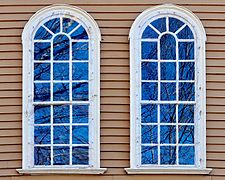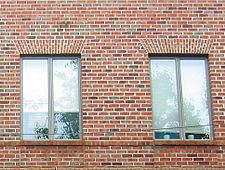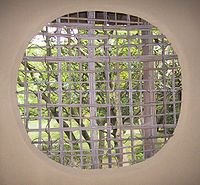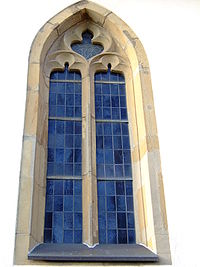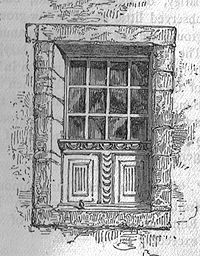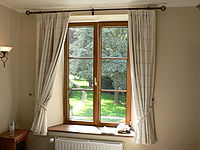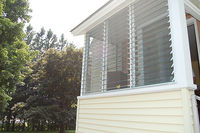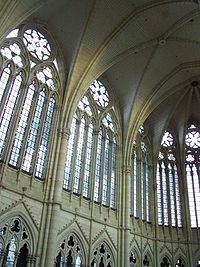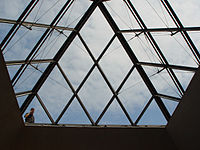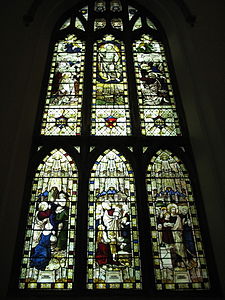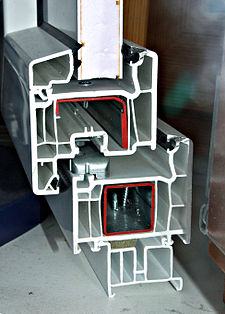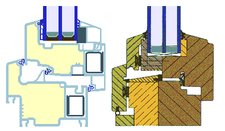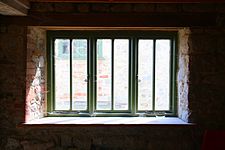- Window
-
This article is about the part of a building. For the Microsoft operating system, see Microsoft Windows. For other uses, see Window (disambiguation) and Windows (disambiguation).
A window is a transparent or translucent opening in a wall or door that allows the passage of light and, if not closed or sealed, air and sound. Windows are usually glazed or covered in some other transparent or translucent material like float glass. Windows are held in place by frames, which prevent them from collapsing in. Many glazed windows may be opened, to allow ventilation, or closed, to exclude inclement weather.
Etymology
The word window originates from the Old Norse ‘vindauga’, from ‘vindr – wind’ and ‘auga – eye’, i.e. "wind eye". In Norwegian Nynorsk and Icelandic the Old Norse form has survived to this day (in Icelandic only as a less used synonym to gluggi), in Swedish the word vindöga remains as a term for a hole through the roof of a hut, and in the Danish language ‘vindue’ and Norwegian Bokmål ‘vindu’, the direct link to ‘eye’ is lost, just like for 'window'. The Danish (but not the Bokmål) word is pronounced fairly similarly to window.
Window is first recorded in the early 13th century, and originally referred to an unglazed hole in a roof. Window replaced the Old English ‘eagþyrl’, which literally means ‘eye-hole,’ and ‘eagduru’ ‘eye-door’. Many Germanic languages however adopted the Latin word ‘fenestra’ to describe a window with glass, such as standard Swedish ‘fönster’, or German ‘Fenster’. The use of window in English is probably due to the Scandinavian influence on the English language by means of loanwords during the Viking Age. In English the word fenester was used as a parallel until the mid-18th century and fenestration is still used to describe the arrangement of windows within a façade.
From Webster's 1828 Dictionary: Window, n. [G. The vulgar pronunciation is windor, as if from the Welsh gwyntdor, wind-door.][1]
History

Primitive windows were just holes in a wall. Later, windows were covered with animal hide, cloth, or wood. Shutters that could be opened and closed came next. Over time, windows were built that both protected the inhabitants from the elements and transmitted light: mullioned glass windows, which joined multiple small pieces of glass with leading, paper windows, flattened pieces of translucent animal horn, and plates of thinly sliced marble. The Romans were the first to use glass for windows. In Alexandria ca. 100 CE, cast glass windows, albeit with poor optical properties, began to appear. Mullioned glass windows were the windows of choice among European well-to-do, whereas paper windows were economical and widely used in ancient China, Korea and Japan. In England, glass became common in the windows of ordinary homes only in the early 17th century whereas windows made up of panes of flattened animal horn[citation needed] were used as early as the 14th century in Northern Britain. Modern-style floor-to-ceiling windows became possible only after the industrial glass making process was perfected.
Types of windows
Double-hung sash window
This sash window is the traditional style of window in the United Kingdom, and many other places that were formerly colonized by the UK, with two parts (sashes) that overlap slightly and slide up and down inside the frame. The two parts are not necessarily the same size. Nowadays, most new double-hung sash windows use spring balances to support the sashes, but traditionally, counterweights held in boxes on either side of the window were used. These were and are attached to the sashes using pulleys of either braided cord or, later, purpose-made chain. Double-hung sash windows were traditionally often fitted with shutters. Sash windows may be fitted with simplex hinges which allow the window to be locked into hinges on one side, while the rope on the other side is detached, allowing the window to be opened for escape or for cleaning.
Single-hung sash window
One sash is movable (usually the bottom one) and the other fixed. This is the earlier form of sliding sash window, and is also cheaper.
Horizontal sliding sash window
Has two or more sashes that overlap slightly but slide horizontally within the frame. In the UK, these are sometimes called Yorkshire sash windows, presumably because of their traditional use in that county.
Casement window
A window with a hinged sash that swings in or out like a door comprising either a side-hung, top-hung (also called "awning window"; see below), or occasionally bottom-hung sash or a combination of these types, sometimes with fixed panels on one or more sides of the sash. In the USA, these are usually opened using a crank, but in parts of Europe they tend to use projection friction stays and espagnolette locking. Formerly, plain hinges were used with a casement stay. Handing applies to casement windows to determine direction of swing; a casement window may be left-handed, right-handed, or double. The casement window is the dominant type now found in the UK and parts of Europe.
Awning window
An awning window is a casement window that is hung horizontally, hinged on top, so that it swings outward like an awning. Emilie Poisson designed this window.
Hopper window
A hopper window is a bottom hung casement window that opens similar to a draw bridge typically opening to the outside.
Tilt and slide window
A window (more usually a door-sized window) where the sash tilts inwards at the top and then slides horizontally behind the fixed pane.
Tilt and turn window
A window which can either tilt inwards at the top, or can open inwards hinged at the side. This is by far the most common type of window in Germany, its country of origin. It is also widespread in many other European countries.[2]
Transom window
A window above a door; in an exterior door the transom window is often fixed, in an interior door it can open either by hinges at top or bottom, or rotate on hinges. It provided ventilation before forced air heating and cooling. A fan-shaped transom is known as a fanlight, especially in the British Isles.
Jalousie window
Also known as a louvered window, the jalousie window consists of parallel slats of glass or acrylic that open and close like a Venetian blind, usually using a crank or a lever. They are used extensively in tropical architecture. A jalousie door is a door with a jalousie window.
Clerestory window
A window set in a roof structure or high in a wall, used for daylighting.
Skylight
A flat or slope window used for daylighting, built into a roof structure that is out of reach.
Roof window
A sloped window used for daylighting, built into a roof structure.
Roof lantern
A roof lantern is a multi-paned glass structure, resembling a small building, built on a roof for day or moon light. Sometimes includes an additional clerestory. May also be called a cupola.
Bay window
A multi-panel window, with at least three panels set at different angles to create a protrusion from the wall line.
Oriel window
A window with many panels. It is most often seen in Tudor-style houses and monasteries. An oriel window projects from the wall and does not extend to the ground. Oriel windows originated as a form of porch. They are often supported by brackets or corbels. Buildings in the Gothic Revival style often have oriel windows.
Thermal window
Thermal, or Diocletian, windows are large semicircular windows (or niches) which are usually divided into three lights (window compartments) by two vertical mullions. The central compartment is often wider than the two side lights on either side of it.
Fixed window
A window that cannot be opened, whose function is limited to allowing light to enter (Unlike an unfixed window, which can open and close). Clerestory windows are often fixed. Transom windows may be fixed or operable. This type of window is used in situations where light or vision alone is needed as no ventilation is possible through fixed windows.
Picture window
A very large fixed window in a wall, typically without glazing bars or glazed with only perfunctory glazing bars near the edge of the window. Picture windows are intended to provide an unimpeded view, as if framing a picture.
Multi-lit window
A window glazed with small panes of glass separated by wooden or lead "glazing bars", or "muntins", arranged in a decorative "glazing pattern" often dictated by the architectural style at use. Due to the historic unavailability of large panes of glass, this was the prevailing style of window until the beginning of the 20th century, and is traditionally still used today.
Emergency exit/egress window
A window big enough and low enough so that occupants can escape through the opening in an emergency, such as a fire. In the United States, exact specifications for emergency windows in bedrooms are given in many building codes. Vehicles, such as buses and aircraft, frequently have emergency exit windows as well.[3]
Stained glass window
A window composed of pieces of colored glass, transparent, translucent or opaque, frequently portraying persons or scenes. Typically the glass in these windows is separated by lead glazing bars. Stained glass windows were popular in Victorian houses and some Wrightian houses, and are especially common in churches.
French window
A French window, also known as a French door is really a type of door, but one which has one or more panes of glass set into the whole length of the door, meaning it also functions as a window. In France, they are known as 'porte-fenêtre'. In Italy they are very common, usually overlooking a terrace, known as portafinestra (door-window).
Technical terms
The term "lite", or "light", refers to a glass pane, several of which may be used to construct the final window product. For example, a sash unit, consisting of at least one sliding glass component, is typically composed of two lites, while a fixed window is composed of one lite. The terms "single-light", "double-light" etc. refer to the number of these glass panes in a window.
The lites in a window sash are divided horizontally and vertically by narrow strips of wood or metal called muntins. More substantial load bearing or structural vertical dividers are called mullions, with the corresponding horizontal dividers referred to as transoms.
In the United States, the term replacement window means a framed window designed to slip inside the original window frame from the inside after the old sashes are removed. In Europe, however, it usually means a complete window including a replacement outer frame.
The U.S., the term new construction window means a window with a nailing fin designed to be inserted into a rough opening from the outside before applying siding and inside trim. A nailing fin is a projection on the outer frame of the window in the same plane as the glazing, which overlaps the prepared opening, and can thus be 'nailed' into place.
In the UK and mainland Europe, windows in new-build houses are usually fixed with long screws into expanding plastic plugs in the brickwork. A gap of up to 13mm is left around all four sides, and filled with expanding polyurethane foam. This makes the window fixing weatherproof but allows for expansion due to heat.
A beam over the top of a window is known as the lintel or transom, while a beam below the bottom of a window is known as the sill plate or windowsill.
In the US, the NFRC Window Label lists the following terms:
- Thermal transmittance (U-factor). Best values are around U-0.15 (equal to 0.8 W/m2/K).
- Solar heat gain coefficient (SHGC) (ratio of solar heat (infrared) passing through the glass to incident solar heat)
- Visible transmittance (VT) (ratio of transmitted visible light divided by incident visible light)
- Air Leakage (AL) (Measured in cubic foot per minute per linear foot of crack between sash and frame)
- Condensation Resistance (CR) (Measured between 1 and 100. The higher the number, the higher the resistance of the formation of condensation.) [4]
Window construction
Windows can be a significant source of heat transfer.[5] Therefore, insulated glazing units consist of two or more panes to reduce the transfer of heat.
Grids or Muntins
These are the pieces of framing that separate a larger window into smaller panes. In older windows, large panes of glass were quite expensive, so muntins allowed smaller panes to fill a larger space. In modern windows, light-colored muntins still provide a useful function by reflecting some of the light going through the window, making the window itself a source of diffuse light (instead of just the surfaces and objects illuminated within the room). By increasing the indirect illumination of surfaces near the window, muntins tend to brighten the area immediately around a window and reduce the contrast of shadows within the room.
Frame and sash construction
Frames and sashes can be made of the following materials:
Material thermal resistance Durability Maintenance Cost Recycled content Comment Wood very good variable high high low shrinks and swells with humidity changes vinyl or PVC very good good* low low very low Aluminum bad** good very low low typically > 95% used in most large structures Steel medium superior very low high > 98% typically welded at corner joints Fiberglass very good very good* very low high medium * Vinyl and fiberglass frames perform well in accelerated weathering tests. Because vinyl is not as strong as other materials, some vinyl frames are reinforced with metal or composite materials to improve their structural strength.
** Modern aluminium window frames are typically separated by a thermal break made of a polyamide. This greatly increases thermal resistance, while retaining virtually all of the structural strength.
Composites may combine materials to obtain aesthetics of one material with the functional benefits of another.
Glazing and filling
Low-emissivity coated panes reduce heat transfer by radiation, which, depending on which surface is coated, helps prevent heat loss (in cold climates) or heat gains (in warm climates).
High thermal resistance can be obtained by evacuating or filling the insulated glazing units with gases such as argon or krypton, which reduces conductive heat transfer due to their low thermal conductivity. Performance of such units depends on good window seals and meticulous frame construction to prevent entry of air and loss of efficiency.
Modern double-pane and triple-pane windows often include one or more low-e coatings to reduce the window's U-factor (its insulation value, specifically its rate of heat loss). In general, soft-coat low-e coatings tend to result in a lower solar heat gain coefficient (SHGC) than hard-coat low-e coatings.
Modern windows are usually glazed with one large sheet of glass per sash, while windows in the past were glazed with multiple panes separated by "glazing bars", or "muntins", due to the unavailability of large sheets of glass. Today, glazing bars tend to be decorative, separating windows into small panes of glass even though larger panes of glass are available, generally in a pattern dictated by the architectural style at use. Glazing bars are typically wooden, but occasionally lead glazing bars soldered in place are used for more intricate glazing patterns.
Other construction details
Many windows have movable window coverings such as blinds or curtains to keep out light, provide additional insulation, or ensure privacy. Windows allow natural light to enter, but too much can have negative effects such as glare and heat gain. Additionally, while windows allow the user to see the outside, there needs to be a way to maintain privacy on in the inside.[6] Window coverings are practical accommodations for these issues.
Windows and the sun
Sun incidence angle
Historically, windows are designed with surfaces parallel to vertical building walls. Such a design allows considerable solar light and heat penetration due to the most commonly occurring incidence of sun angles. In passive solar building design, an extended eave is typically used to control the amount of solar light and heat entering the window(s).
An alternate method would be to calculate a more optimum angle for mounting windows which accounts for summer sun load minimization, with consideration of the actual latitude of the particular building. An example where this process has been implemented is the Dakin Building, Brisbane, California; much of the fenestration has been designed to reflect summer heat load and assist in preventing summer interior over-illumination and glare, by designing window canting to achieve a near 45 degree angle.
Solar window
Photovoltaïc windows not only provide a clear view and illuminate rooms, but also use sunlight to efficiently help generate electricity for the building.[7] In most cases, translucent photovoltaïc cells are used.
Window coverings
A window covering is a shading or screening device that can be used for multiple purposes. For example, some window coverings are used to control solar heat gain and glare. Typically, there are external shading devices and internal shading devices.[8] Low-e window film is a low-cost alternative to window replacement to transform existing poorly-insulating windows into energy-efficient windows.
For high-rise buildings, smart glass can be used as an alternative.
See also
- Irving Wightman Colburn
- Defenestration
- Equip'baie
- G-value
- Insulated glazing
- Porthole
- Replacement window
- Shop window
- Trickle vent
- Window blind
- Window film
- Window tax
- Wood preservation
- Window treatment
- Witch window
References
- ^ "1828 Webster". Foundation for AHA. October 16, 2009. http://www.1828-dictionary.com/d/search/word,window. Retrieved 2010-05-02.
- ^ http://www.windowanddoor.com/article/products/will-tilt-and-turn-windows-gain-market-share-north-america?page=0%2C1
- ^ U.S. Dept. of Transportation: Safety information for bus/motorcoach passengers
- ^ NRC Heat Loss Fact Sheet
- ^ Carmody, J., Selkowitz, S., Lee, E. S., Arasteh, D., & Willmert, T. (2004). Window Systems for High-Performance Buildings. New York, NY: W. W. Norton & Company, Inc.
- ^ Howell, Sandra C. (1976). Designing for the Elderly; Windows. Massachusetts Institute of Technology. Department of Architecture. Design Evaluation Project.
- ^ MIT opens new 'window' on solar energy
- ^ Beckett, H. E., & Godfrey, J. A. (1974). Windows: Performance, design and installation. New York, NY: Van Nostrand Reinhold Company.
External links
Categories:- Windows
- Architectural elements
- Glass
Wikimedia Foundation. 2010.

